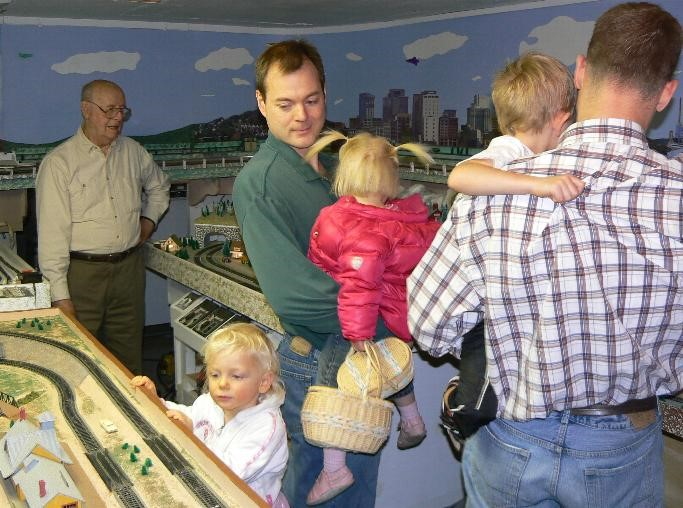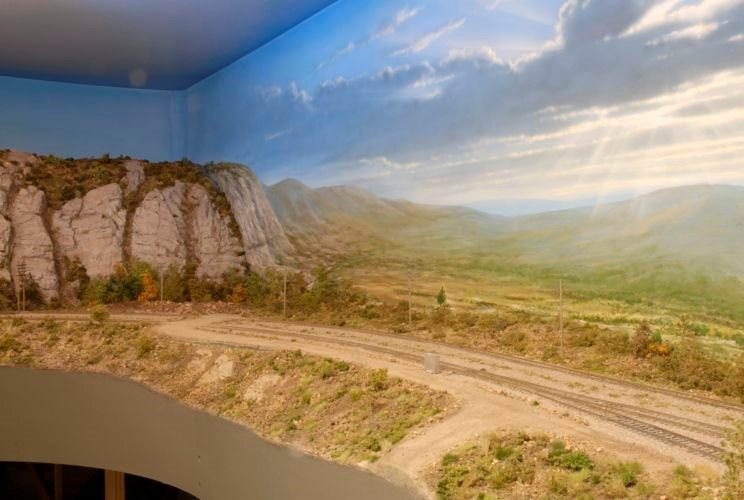Why Participate in Model Railroading?
As with any hobby, the obvious answer is because it's fun!
If you've made it this far, you're probably already interested in building a model railroad for some reason. But maybe you're still on the fence. After all, a model railroad requires an investment in time, money, and energy.
Family Oriented
We are constantly looking for things to do together, "as a family".
 "Pop", age 88, sharing his layout room with two of his grandsons and three of his many great grandchildren.
"Pop", age 88, sharing his layout room with two of his grandsons and three of his many great grandchildren.
Building a model railroad is a great family-oriented hobby. Everyone can get involved and everyone can participate "together". Every member of the family can be working on some part of things. Mom can be building this part, dad working on that, while the kids are working on something else. As seen in the picture above, it is also a hobby that can last a life-time. Many people in the hobby started when they were kids and it stayed with them.
Model Railroading is Educational
You probably don't want to tell your kids, but Model Railroading can be very educational. You can learn a whole range of things:
History
- Railroads reflect the times they operated in, and vice versa.
- Building a model railroad leads to learning about prototype railroads, their times and their settings.
- Railroads were, and are, equally important in the histories of other countries.
Basic Carpentry and Electrical Skills
- If you've never sawed wood or stripped some wire, You will!
- Building a model railroad requires these skills.
- You might think that they are "hard" -- they aren't, you just need to start down the path.
- You'll be surprised how easy it is to pick them up!
Economics
- Railroads are economic entities.
- They move raw materials and manufactured goods from place to place.
- The patterns of these movements are all driven by economics.
Model building
- This is pretty straight forward! After all, we are building a Model Railroad.
- There are a whole range of skills that you'll develop over time.
Artistic Techniques
- Building scenery and weathering cars, among others, all require a bit of an artistic touch. We can learn that "less is more" (for instance, sometimes just a bit of weathering on a car is all that's really needed).
- We can learn that we don't always need a perfect rendition of something, sometimes all we really need is to give the impression.
 Did someone say Artistic Techniques? Where does the scenery stop and the backdrop start in this scene on Tim Kerkhoff's HO scale Overland Green River Basin RR?
Did someone say Artistic Techniques? Where does the scenery stop and the backdrop start in this scene on Tim Kerkhoff's HO scale Overland Green River Basin RR?
Conducting Research
- As you get more interested in model railroading, you might decide to build more accurate models or replicate specific scenes on a particular prototype railroad.
- To do this you will need to research "the real things".
- Conducting research about a railroad, a piece of motive power or rolling stock, or a structure is an interesting facet of the hobby. The Internet, railroad historical societies, and print publications are all good resources for research. And don't forget the extensive collection of photographs that the NMRA has here on the website.
Logical Thought and Planning
- From novice model railroader to Master Model Railroader (MMR®), logical thought and planning are important.
- Everything from figuring out the right steps for building a kit to designing a layout to developing an operating plan for your railroad all require logical thought and planning.
3D and Spatial Visualization
- When you decide to take on scratch-building and kit-bashing, you'll quickly learn some of these skills. We often have to visualize how things will finally look, or how they will go together, long before they are done.
Develops Manual Skills
- This is pretty self-evident.
- To build a model railroad requires some manual dexterity and skills.
- You can't be "all thumbs" to build one.
- And if you think you are all-thumbs, you'll quickly discover that you are not all thumbs.
Basic Engineering
- Model Railroads themselves require a bit of engineering to construct.
- We obviously don't want the benchwork to collapse or the electrical wiring to burst into flames!
- But we can also learn a bit of engineering by studying the prototypes for the models we are building;
- Why are bridges built this way and not that?
- Why did the railroad go this way instead of that way?
- How does an engine work?
Geography
- Railroads don't exist in a vacuum.
- They go through the landscape.
- There are mountains and plains, forests and rivers, towns and cities.
- Model railroading can develop basic understandings of all of these geographic features.
- Furthermore, if you decided to research and model a specific real railroad you can learn a lot about the specific geographic regions where that railroad operated.
The Internet and The Web
- You can even learn a lot about The Internet and how to make and run web sites. After all, we put together this web site!
But the best part of it all is that you are not forced to learn much. You can derive as much, or as little, education from the hobby as you want. After all, sometimes we just want to have fun!
Social Aspects
- Model Railroading can be a very social hobby.
- It's a great way to meet new people.
- There are clubs and associations (such as the NMRA) that you can join. These clubs run the whole range, from swapping stories to teaching skills to each other, to actually building and running a permanent model railroad.
- There are model building contests.
- It's also a great excuse to travel! You can go on rail-fanning trips, go to conventions and shows, or to visit people you've met.
- Model railroading appeals to people in all walks of life. If you find a group of model railroaders, you'll find doctors and lawyers, engineers, shop keepers, business people, military folks, mechanics, carpenters, artists, athletes, and politicians. Young and old, rich and poor. And it is fun.
The NMRA
You are here visiting the NMRA Website, so you have some awareness of the organization. Let’s take a few minutes to learn a little more.
The NMRA is an international organization dedicated to Scale Model Railroading. It is organized into 18 Regions which cover the United States, Australasia, Canada, the British Isles and Europe. The NMRA Regions elect officers and publish newsletters. Each Region holds one or more
conventions each year, usually two-day affairs on weekends, making it easy for members to attend.
The Regions are further divided into Divisions, which also have officers and publish newsletters. Most Divisions hold several events each year. It is at the Division level that you get to interact with fellow model railroaders near you.
It is the social and educational (e.g., live clinics, the NMRA Magazine, and the Members-Only side of the Website) aspect of the NMRA that drives most members to join the organization. However, there is also a financial benefit to joining the NMRA. There are currently over 40 companies that provide discounts up to 45% to NMRA members who purchase their products.
So, if you enter the hobby of scale model railroading, we invite you to join the NMRA!
The Beginners’ Guide
Recently, the NMRA Board of Directors decided that it was time to update and revise the Beginners’ Guide that resides on the public side of the NMRA website. Not surprisingly, that task was assigned to the NMRA’s Education Department. Education Department Manager Bruce DeYoung, MMR® and a group of volunteers are responsible for the twelve Parts of the Guide that follow.
The participants in this year-long process deserve some recognition.
First there are two Regions and one Division who had developed their own versions of beginners guides and made those available to the Committee. The Committee was guided both in organization and content by the work of these three groups:
- The Australasian Region
- The British Region
- Division 6 (Motor City Division) of the North Central Region
The individuals below are recognized for developing the content of the twelve Parts of the Guide.
- Part 1 Getting Started: Doug Geiger, MMR® (NMRA Rocky Mountain Region) & Mike Arnold (British Region)
- Part 2 Layout Planning: Peter Thomas (Southeastern Region) & Mike Hohn, MMR® (Mid-Central Region)
- Part 3 Building Benchwork: Division 6 (North Central Region) & Bruce DeYoung, MMR® (North Central Region)
- Part 4 Laying Track: Division 6 (North Central Region) & Bruce Wolf (North Central Region)
- Part 5 Adding Power: Division 6 (North Central Region) & Joe Bliss (North Central Region)
- Part 6 Scenery: Bob Hamm, MMR® (Sunshine Region) and John Pursell (Mid-Eastern Region)
- Part 7 Structures: Mike Hohn, MMR® (Mid-Central Region) and Steve Wysowski (Northeastern Region)
- Part 8 Motive Power & Rolling Stock: Larry Wolohon, MMR® (North Central Region)
- Part 9 Operations: Peter Thomas (Southeastern Region) & Bruce DeYoung, MMR® (North Central Region)
- Part 10 Weathering: Bruce DeYoung, MMR® (North Central Region)
- Part 11 Tools: Jack Hamilton, MMR® (Pacific Northwest Region)
- Part 12 Special Focus Layout Themes:
- Narrow Gauge Modeling: Bob Hamm, MMR® (Sunshine Region)
- Logging Railroads: Bruce DeYoung, MMR® (North Central Region)
- Early Rail: Mike Hohn, MMR® (Mid-Central Region)
Please Note: The usual disclaimers will apply. Even though we will examine tools, construction methods, and electrical wiring, it is assumed that you have some very basic knowledge of these items. In other words, if you smash your fingers with a hammer, it's not our fault! For more information, visit the
Safety Page.
A very special thanks to Mike Hohn, MMR® (Mid-Central Region), and his team, for his proof-reading and editing of every part of the Guide.
We hope that you find the content of the Guide helpful as you begin your journey into Model Railroading. The Guide contains enough information for you to go from purchasing your first “train set” to earning the NMRA’s
Golden Spike Award! Enjoy the journey!

